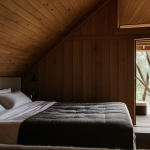Quick DIY Upgrades for Any Room
Small, quick upgrades can significantly transform any space without requiring advanced skills or a large budget. For beginner-friendly DIY home projects, focus on tasks that deliver visible impact with minimal tools and time.
Consider freshening up walls with peel-and-stick decals or applying a bright coat of paint. Both are affordable, needing just decals or paint, brushes, and tape—materials available at most hardware stores. Adding new hardware to cabinets or drawer pulls can also revitalize furniture with a small cost.
Have you seen this : How Can You Transform Your UK Home into a Zen Retreat?
Lighting changes, like swapping old fixtures for modern ones or adding plug-in wall sconces, enhance ambiance instantly. Safety is essential: use a sturdy ladder, wear gloves when handling paint or tools, and keep your workspace tidy to avoid accidents.
For a quick upgrade, layering textiles such as new throw pillows or rugs adds color and texture, boosting comfort and style. These minor improvements combine easily, allowing you to tailor your approach based on your budget and time, offering a satisfying, visible makeover in any room.
Also read : How Can You Transform Small Spaces into Cozy Havens?
Quick DIY Upgrades for Any Room
For those seeking quick upgrades that are both impactful and accessible, focusing on DIY home projects suited to beginner skill levels is essential. These projects often require minimal materials, such as paint, decals, or hardware, making budgeting straightforward and affordable.
When selecting a project, prioritize those that maximize visual change per effort—like adding peel-and-stick wallpaper or replacing old cabinet pulls. These tasks transform rooms effectively without needing advanced tools or specialized experience. For example, swapping drawer handles can cost under $20 but refreshes furniture appearance noticeably.
Safety remains paramount for first-time DIYers. Always wear protective gloves when painting or handling sharp objects, use a stable ladder when working at height, and ensure your workspace is free of trip hazards. Preparing materials in advance reduces mistakes and improves efficiency.
By choosing beginner-friendly projects tailored to your available budget and time, you achieve satisfying room makeovers without overwhelming complexity. Combining small projects—fresh paint, new hardware, enhanced lighting—delivers cohesive, stylish results that breathe new life into any space.
Quick DIY Upgrades for Any Room
For impactful DIY home projects that suit beginners, prioritize quick upgrades requiring minimal tools but offering visible results. Projects like applying peel-and-stick wallpaper or decals, swapping cabinet handles, and updating light fixtures focus effort where it shows most. These room makeovers often need only basic materials: paint, adhesives, hardware, or new light bulbs.
Budget-wise, many options range from $10 to $50, ensuring affordability without sacrificing style. For example, changing cabinet pulls for under $20 refreshes furniture instantly, while plug-in wall sconces add charm without rewiring.
When selecting materials, consider durability and ease of use to prevent frustration. Many peel-and-stick decals remove cleanly, making them beginner-friendly. Choose finishes and colors that complement your existing decor for more cohesive results.
Safety is crucial for first-time DIYers. Always ensure a stable ladder when working overhead, wear gloves when handling paint or sharp items, and keep your workspace organized to avoid accidents. Preparing and measuring carefully beforehand reduces errors and supports smoother project completion.
By focusing on simple yet effective upgrades with appropriate safety and budget considerations, these small-scale projects enable satisfying room makeovers for any home.
Quick DIY Upgrades for Any Room
For effective DIY home projects focused on quick upgrades, selecting tasks with high visual impact and beginner suitability is key. Consider projects like refreshing room color with a single accent wall using peel-and-stick wallpaper or decals. These require only adhesive materials, a utility knife, and a measuring tape, keeping tools minimal and budget-friendly.
Upgrading hardware, such as cabinet knobs or drawer pulls, remains a popular, affordable choice costing under $20. It provides an immediate update without expertise. Additionally, swapping outdated light bulbs for energy-efficient, warmer-toned LEDs can change ambiance while lowering energy costs.
For budgets, projects under $50 are common and manageable. Materials for small paint jobs or simple lighting upgrades are widely available at hardware stores, easing the process. Planning ahead by measuring surfaces and gathering all materials before starting prevents delays and errors.
First-time DIYers should prioritize safety: always use a sturdy ladder when working above waist height, wear gloves when handling paint or sharp tools, and maintain a clear workspace to avoid accidents. Applying painter’s tape around edges ensures clean lines, reducing frustration.
Such room makeovers balance cost, time, and style, delivering rewarding results with minimal complexity.
Quick DIY Upgrades for Any Room
When aiming for quick upgrades in your home, focusing on DIY home projects that combine high impact with beginner-friendly steps is essential. One effective strategy is targeting small-scale tasks like replacing cabinet handles, applying peel-and-stick decals, or changing light bulbs. These projects demand minimal investment—often under $50—and limited tools, ensuring easy access for novices.
For materials, opt for durable, user-friendly options. Peel-and-stick decals, for example, require no adhesive beyond what comes with them and can be repositioned to correct mistakes, making them ideal for first-time DIYers. Hardware changes often come with installation instructions and need only basic screwdrivers. Lighting swaps may involve unplugged fixture replacements or plug-in sconces, eliminating wiring hassles.
Safety should never be overlooked. Always use a stable ladder when reaching heights, wear gloves to protect hands from paint or sharp objects, and clear your workspace to prevent accidents. Carefully measuring and preparing materials before starting each project reduces errors, making the process smoother and more enjoyable.
By integrating these approaches, even those new to DIY can accomplish gratifying room makeovers that enhance style and function without complexity.






